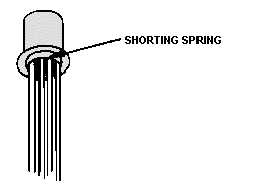3-50
One problem with both the single- and dual-gate MOSFETs is that the oxide layer between gate and
channel can be destroyed very easily by ordinary static electricity. Replacement MOSFETs come
packaged with their leads shorted together by a special wire loop or spring to avoid accidental damage.
The rule to remember with these shorting springs is that they must not be removed until after the
MOSFET has been soldered or plugged into a circuit. One such spring is shown in figure 3-58.
Figure 3-58.—MOSFET shorting spring.
Q30. What is one of the primary advantages of the FET when compared to the bipolar transistor?
Q31. The FET and the vacuum tube have what in common?
Q32. The base of a transistor serves a purpose similar to what element of the FET?
Q33. What are the two types of JFET?
Q34. The source and drain of an N-channel JFET are made of what type of material?
Q35. What is the key to FET operation?
Q36. What is the normal current path in an N-channel JFET?
Q37. Applying a reverse bias to the gate of an FET has what effect?
Q38. The input and output signals of a JFET amplifier have what phase relationship?
Q39. When compared to the JFET, what is the input impedance of the MOSFET?
Q40. What are the four elements of the MOSFET?
Q41. The substrate of an N-channel MOSFET is made of what material?
Q42. In a MOSFET, which element is insulated from the channel material?
Q43. What type of MOSFET can be independently controlled by two separate signals?
Q44. What is the purpose of the spring or wire around the leads of a new MOSFET?

